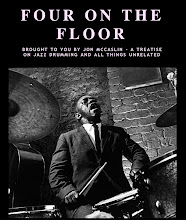
About ten years ago I had the opportunity to hear the great Elvin Jones give a masterclass in Montreal, Quebece at the Salle Gesu concert hall. It was part of a clinic "tour" sponsored by Yamaha and consisted of a series of clinics in Toronto, Ottawa and Montreal. Check out the photo at the very bottom of Elvin decked out in his Habs jersey !
(go leafs)
It was a brilliant clinic on so many levels. Jones talked at length about his career, his influences and his experience playing with John Coltrane among other things. He also played quite a bit and demonstrated his approach to using the rudiments (in a very loose, march-like context that only Elvin can pull off), his brushwork, his soloing with mallets and his loose, broken approach to timekeeping in 3/4. It seems like just yesterday that Jones passed away, so I consider my lucky to have seen Elvin as many times as I did.
Lucky for us, Elvin even went as far as to describe some of his technical concepts in great detail, actual exercises that he had worked on that allowed him to develop his unique, revolutionary and highly influential style of jazz drumming. I wasn't really expecting Jones to be so specific in explaining his technique so this all took me by surprise at the time. The following exercises are from notes I took as best as I could and from my memory.
1) Elvin's Inner Triplet Exercise:
The first patterns that Elvin demonstrated deal with different ways that he voiced inner triplet subdivisions around the drum set in the context of the jazz ride cymbal rhythm. By exposing and giving more attention to those inner triplets, it serves to help open up and stretch the beat quite a bit. This is something Elvin was renowned for.
Play the following pattern with the Right hand on the ride cymbal, filling in the missing triplets on the snare drum with the Left hand:

The basic sticking pattern resembles this:
RLL RLR RLL RLR RLL RLR RLL RLR etc.
The next pattern is the Left hand snare drum pattern/inner triplet pattern isolated:

So this is the pattern that we are going to concern ourselves with within the context of the ride cymbal pattern.
While playing the steady ride cymbal rhythm, play the inner triplets in the following sequences (or "cells" as I like to call them) between the Left hand, hihat and bass drum using the inner triplet rhythm from above:
S = Snare drum
B = Bass drum
H = Hihat
----------------------------------------------------------------------------------
THREE VOICE VARIATIONS
S B H
S H B
B S H
B H S
H S B
H B S
This is what the first four variations would look like:

----------------------------------------------------------------------------------
TWO VOICE VARIATIONS
S S B
S B S
B S S
B B S
B S B
S B B
S S H
S H S
H S S
H H S
H S H
S H S
B B H
B H B
H B B
H H B
H B H
B H H
----------------------------------------------------------------------------------
Repeat each of these cells or mix them up (as illustrated above) but the key is to keep the ride cymbal pattern steady and maintain a constant and even linear triplet pattern between the limbs. It's a relatively easy pattern but you'll find - as Elvin demonstrated (of course in a much more simpler manner !) that these different variations distort the time and stretch the beat in very interesting ways.
*Another nice variation that I discovered today is to play all the variations I described above with Brushes on the snare drum (i.e. with both hands on the snare drum) Try to incorporate some sore of sweeping motion with the Left hand while playing these patterns*
2) Elvin's Polyrhythmic Exercise
The following is a pattern that Elvin described as the foundation for his poly-rhythmic approach to the drums. Light bulbs were going off in the audience as he played this !
The hand pattern looks like this:

Basically you are playing the jazz ride cymbal rhythm with the Right hand while playing quarter note triplets on the snare drum with your Left. However the quarter note triplets don't start on the downbeat and instead start on the second eighth note. This pattern implies a displaced 3 against 2 polyrhythm.
Here is the displaced quarter note triplet rhythm isolated:

Once you've got that down with the hands, add the following bass drum and hihat pattern underneath.

This is the tricky part !
While the hihat is only playing beats 2 & 4, the bass drum is playing dotted quarter notes in a cycle that last 3 measures of 4/4 time. This pattern represents a 2 against 3 polyrhythm, but on a larger scale. So when you add the hands and feet together you will get two different layers of polyrhythms happening at the same time. It takes a bit of time to get together but it's highly effective when you do. Elvin used this pattern all the time and you can hear him playing it on such albums as Sonny Rollins' "A Night at the Village Vanguard" and my favorite Lee Konitz record "Motion".
I hope my explanation of these exercises has been clear enough : )
Thank you Elvin.










































